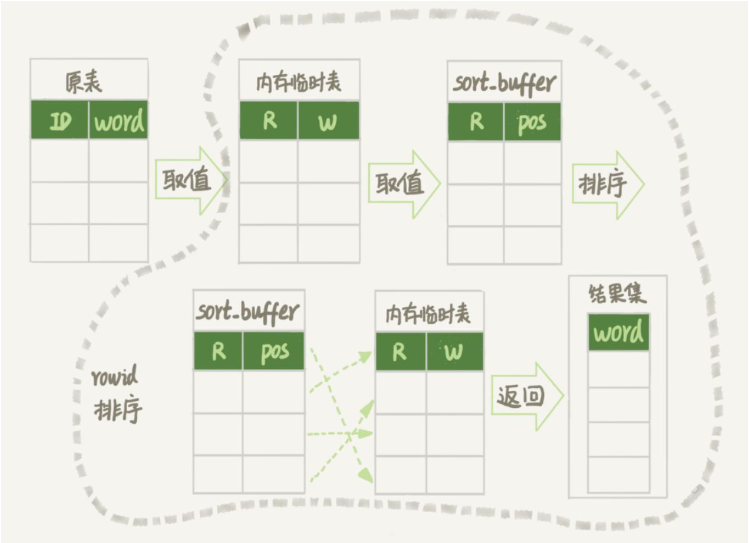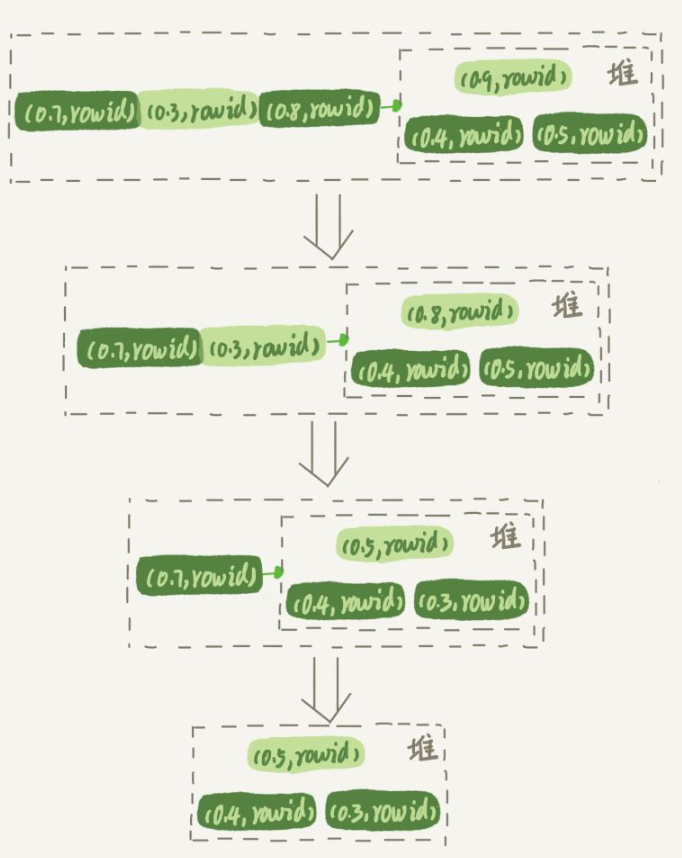How to implement random extraction in MySQL
1. Introduction
Now there is a requirement to randomly select three words at a time from a word list.
The table creation statement of this table is as follows:
mysql> Create table 'words'(
'id' int(11) not null auto_increment;
'word' varchar(64) default null;
primary key ('id')
) ENGINE=InnoDB;Then we insert 10,000 rows of data into it. Next let's see how to randomly select 3 words from it.
2. Memory temporary table
First of all, we usually think of using order by rand() to implement this logic:
mysql> select word from words order by rand() limit 3;
Although this sentence is very simple, but the execution The process is more complicated. We use explain to see the execution of the statement:

Using temporary in the Extra field indicates that a temporary table needs to be used, and Using filesort indicates that sorting is required. That is to say, sorting operation is required.
For InnoDB tables, performing full field sorting can reduce disk access, so it will be preferred.

#For memory tables, the table return process simply directly accesses the memory to obtain the data based on the location of the data rows, and does not result in multiple disk accesses at all. . So at this time MySQL will give priority to rowid sorting.

Let’s sort out the execution process of this statement:
Create a temporary table, this table Using the memory engine, there are two fields in the table. The first field is of double type, marked as R, and the second field is of varchar(64) type, marked as W. And this table has no index.
From the words table, take out all words in primary key order. For each word, call the rand() function to randomly generate a random decimal number greater than 0 and less than 1, and store the random decimal number and the word in the R and W fields of the temporary table respectively.
The next step is to sort according to field R
Initialize sort_buffer. sort_buffer includes a double type and an integer field.
Take out the R value and position information row by row from the temporary memory table, and store them in the two fields of sort_buffer respectively.
sort_buffer is sorted according to the R value
After the sorting is completed, the location information of the first three results is taken out, and the corresponding information is taken out from the memory temporary table The word is returned to the client.
The process diagram is as follows:

The location information mentioned above is actually the location of the row, that is, This is the rowid we mentioned before.
For the InnoDB engine, there are two processing methods for tables with or without primary keys:
For InnoDB tables with primary keysFor example, this rowid is the primary key id
For InnoDB tables without primary keys, this rowid is generated by the system and is used to identify different rows .
Therefore, order by randn() uses a memory temporary table, and the sorting method of the memory temporary table uses the rowid sorting method.
3. Disk temporary table
Not all temporary tables are memory temporary tables. The tmp_table_size configuration limits the size of the memory temporary table. If this size is exceeded, the disk temporary table will be used. The InnoDB engine uses disk temporary tables by default.
4. Priority queue sorting algorithm
After MySQL5.6, the priority queue sorting algorithm was introduced. This algorithm does not require the use of temporary files. The original merge sort algorithm requires the use of temporary files.
Because when you use the merge algorithm, you actually only need to get the top 3, but if you run out of merge sort, the whole thing is already in order, causing a waste of resources.
The priority queue sorting algorithm can only take the top three. The execution process is as follows:
For these 10,000 (R, rowid) to be sorted, the top three are taken first. Three rows are constructed into a heap, and the largest value is placed on the top of the heap;
Take the next row (R’, rowid’) and compare it with the largest R in the current heap. If R’ is less than R, remove (R, rowid) from the heap and replace it with (R’, rowid’).
Repeat the above process.
The process is shown in the figure below:

But when the limit number is relatively large, it is more difficult to maintain the heap, so it will Use the merge sort algorithm.
The above is the detailed content of How to implement random extraction in MySQL. For more information, please follow other related articles on the PHP Chinese website!

Hot AI Tools

Undresser.AI Undress
AI-powered app for creating realistic nude photos

AI Clothes Remover
Online AI tool for removing clothes from photos.

Undress AI Tool
Undress images for free

Clothoff.io
AI clothes remover

AI Hentai Generator
Generate AI Hentai for free.

Hot Article

Hot Tools

Notepad++7.3.1
Easy-to-use and free code editor

SublimeText3 Chinese version
Chinese version, very easy to use

Zend Studio 13.0.1
Powerful PHP integrated development environment

Dreamweaver CS6
Visual web development tools

SublimeText3 Mac version
God-level code editing software (SublimeText3)

Hot Topics
 PHP's big data structure processing skills
May 08, 2024 am 10:24 AM
PHP's big data structure processing skills
May 08, 2024 am 10:24 AM
Big data structure processing skills: Chunking: Break down the data set and process it in chunks to reduce memory consumption. Generator: Generate data items one by one without loading the entire data set, suitable for unlimited data sets. Streaming: Read files or query results line by line, suitable for large files or remote data. External storage: For very large data sets, store the data in a database or NoSQL.
 How to use MySQL backup and restore in PHP?
Jun 03, 2024 pm 12:19 PM
How to use MySQL backup and restore in PHP?
Jun 03, 2024 pm 12:19 PM
Backing up and restoring a MySQL database in PHP can be achieved by following these steps: Back up the database: Use the mysqldump command to dump the database into a SQL file. Restore database: Use the mysql command to restore the database from SQL files.
 How to optimize MySQL query performance in PHP?
Jun 03, 2024 pm 08:11 PM
How to optimize MySQL query performance in PHP?
Jun 03, 2024 pm 08:11 PM
MySQL query performance can be optimized by building indexes that reduce lookup time from linear complexity to logarithmic complexity. Use PreparedStatements to prevent SQL injection and improve query performance. Limit query results and reduce the amount of data processed by the server. Optimize join queries, including using appropriate join types, creating indexes, and considering using subqueries. Analyze queries to identify bottlenecks; use caching to reduce database load; optimize PHP code to minimize overhead.
 How to insert data into a MySQL table using PHP?
Jun 02, 2024 pm 02:26 PM
How to insert data into a MySQL table using PHP?
Jun 02, 2024 pm 02:26 PM
How to insert data into MySQL table? Connect to the database: Use mysqli to establish a connection to the database. Prepare the SQL query: Write an INSERT statement to specify the columns and values to be inserted. Execute query: Use the query() method to execute the insertion query. If successful, a confirmation message will be output.
 How to create a MySQL table using PHP?
Jun 04, 2024 pm 01:57 PM
How to create a MySQL table using PHP?
Jun 04, 2024 pm 01:57 PM
Creating a MySQL table using PHP requires the following steps: Connect to the database. Create the database if it does not exist. Select a database. Create table. Execute the query. Close the connection.
 How to use MySQL stored procedures in PHP?
Jun 02, 2024 pm 02:13 PM
How to use MySQL stored procedures in PHP?
Jun 02, 2024 pm 02:13 PM
To use MySQL stored procedures in PHP: Use PDO or the MySQLi extension to connect to a MySQL database. Prepare the statement to call the stored procedure. Execute the stored procedure. Process the result set (if the stored procedure returns results). Close the database connection.
 How to fix mysql_native_password not loaded errors on MySQL 8.4
Dec 09, 2024 am 11:42 AM
How to fix mysql_native_password not loaded errors on MySQL 8.4
Dec 09, 2024 am 11:42 AM
One of the major changes introduced in MySQL 8.4 (the latest LTS release as of 2024) is that the "MySQL Native Password" plugin is no longer enabled by default. Further, MySQL 9.0 removes this plugin completely. This change affects PHP and other app
 The difference between oracle database and mysql
May 10, 2024 am 01:54 AM
The difference between oracle database and mysql
May 10, 2024 am 01:54 AM
Oracle database and MySQL are both databases based on the relational model, but Oracle is superior in terms of compatibility, scalability, data types and security; while MySQL focuses on speed and flexibility and is more suitable for small to medium-sized data sets. . ① Oracle provides a wide range of data types, ② provides advanced security features, ③ is suitable for enterprise-level applications; ① MySQL supports NoSQL data types, ② has fewer security measures, and ③ is suitable for small to medium-sized applications.






